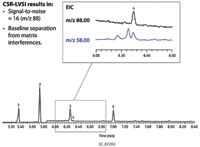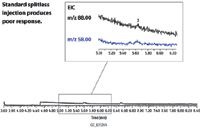Lowering Detection Limits for 1,4-Dioxane in Drinking Water Using Large Volume Injection in an Unmodified Splitless GC Inlet
The Application Notebook
Concurrent solvent recondensation–large volume splitless injection (CSR-LVSI), an alternative to programmed temperature vaporization (PTV), typically requires a special GC inlet. The technique described here uses an unmodified split/splitless inlet with CSR-LVSI to lower detection limits for the analysis of 1,4-dioxane in drinking water.
Concurrent solvent recondensation–large volume splitless injection (CSR-LVSI), an alternative to programmed temperature vaporization (PTV), typically requires a special GC inlet. The technique described here uses an unmodified split/splitless inlet with CSR-LVSI to lower detection limits for the analysis of 1,4-dioxane in drinking water.
Global concern over the carcinogenic potential of 1,4-dioxane, along with its identification as a Group 2B compound by the World Health Organization's International Agency for Research on Cancer (IARC), has led to increased regulatory interest in this compound. For example, as part of Unregulated Contaminant Monitoring Rule 3 (UCMR3), the US EPA is requiring increased monitoring of 1,4-dioxane in drinking water and has revised the 1×10-6 cancer risk assessment level down to 0.35 µg/L. This risk assessment level corresponds to the lifetime probability of one individual in an exposed population of one million developing cancer, and it is the basis for the UCMR3 proposed minimum reporting level (MRL) for 1,4-dioxane of 0.07 µg/L (1).
Concurrent solvent recondensation–large volume splitless injection (CSR-LVSI), a technique described by Magni and Porzano (2,3), can be advantageous when trying to analyze trace-level contaminants, such as 1,4-dioxane, in clean matrices like drinking water. Since more target compound is introduced onto the analytical column, detectability is improved; however, a specialized injection port, such as a PTV, is generally required (4). Using a PTV inlet is not an option for analyzing 1,4-dioxane in drinking water, because this technique requires a difference in boiling point temperature (Tboil) between the solvent and solute of over 100 °C, in order to prevent loss of target analytes to the split vent when performing solvent removal (5). In this case, the temperature difference is not adequate, as dichloromethane (Tboil = 40 °C) is the SPE elution solvent and 1,4-dioxane (Tboil = 101 °C) is the primary solute of interest.
Building on work by chemists at Thermo Scientific, who have successfully applied their CSR-LVSI technique to drugs-of-abuse, pesticides, and polychlorinated biphenyls (6–8), our lab has been exploring the use of CSR-LVSI with a completely unmodified Agilent-style splitless GC inlet. Given how close the boiling points of the compounds in question are to the cartridge elution solvent, we theorized our CSR-LVSI approach would be especially applicable for analyzing 1,4-dioxane in drinking water according to US EPA Method 522. We used a fast autosampler injection with liquid sample band formation in a liner containing glass wool, a retention gap press-fitted to the analytical column, and a starting GC oven temperature below the boiling point of the solvent. Previously, we had successfully analyzed a variety of compounds, including polycyclic aromatic hydrocarbons (PAHs), total petroleum hydrocarbons (TPH), EPA Method 8270 semivolatiles (9), brominated flame retardants (10), as well as many organochlorine, organonitrogen, and organophosphorus pesticides using this technique. Here we assess its potential to lower detection limits for 1,4-dioxane in drinking water.
Experimental Conditions
Calibration Range
Calibration curves at 1–1000 pg/µL and 0.5–50 pg/µL were prepared using 1,4-dioxane and deuterated tetrahydrofuran (THF-d8) as the internal standard. Calibration levels and equivalent concentrations are shown in Table I for the lowest curve, which was used to quantify recoveries from extracted drinking water samples.

Table I: Calibration curve (0.5â50 pg/µL)
Sample Preparation
Fortified samples and extraction blanks were prepared using deionized reagent water and bottled drinking water purchased from a local grocery store. The following standards were used: 1,4-dioxane (cat.# 30287), internal standard tetrahydrofuran-d8 (cat.# 30112), and surrogate standard 1,4-dioxane-d8 (cat.# 30614). Fortification levels are shown in Table II; the internal standard was added at 10 pg/µL. The surrogate standard was added at 0.010 µg/L and 0.020 µg/L, depending on the amount of sample extracted, so that the extract would have a final surrogate concentration of 0.010 µg/mL. The bottled waters were fortified while still in their plastic bottles, recapped, mixed by inversion and allowed to sit for several hours to ensure homogeneous samples.

Table II: CSR-LVSI allowed for excellent quantitative performance for trace levels of 1,4-dioxane in water
Each sample was extracted using a Resprep® activated coconut charcoal SPE cartridge (cat.# 26032) following EPA Method 522 protocol. Immediately after solvent elution, the extracts were spiked with 20 µL of internal standard and brought up to 10 mL final volume as specified in the method, resulting in a concentration of 10 pg/µL in the extract. The extracts were then transferred to a large storage vial and dried with anhydrous magnesium sulfate to take advantage of its more complete drying capacity (this was a deviation from the method, which calls for sodium sulfate).
GC–MS Conditions
A fast autosampler injection with an Agilent 7683 injector was used to make large volume (10 µL) injections from a 25 µL SGE autosampler syringe (cat.# 24798). A Sky™ 4 mm single taper liner with wool (cat.# 23303) placed at the bottom of the liner was installed into an unmodified Siltek® -treated EZ Twist Top® split/splitless injection port at 120 °C. The purge valve time was set at 1 min. A deactivated 5 m × 0.25 mm i.d. Rxi® retention gap (cat.# 10029) was installed in the GC inlet and press-fitted (deactivated Universal Press-Tight® connector, cat.# 20429) to a 30 m × 0.25 mm × 1.4 µm Rxi® -624Sil MS column (cat.# 13868). The oven was programmed from 35 °C (hold 1 min) to 120 °C (hold 1 min) at 12 °C/min, with a constant flow of 1.4 mL/min helium carrier gas. All analyses were performed on an Agilent 7890A GC with a 5975C quadrupole mass spectrometer operated in selected ion monitoring mode. For complete conditions and SIM program, visit www.restek.com and enter GC_EV1263 in the search.
Results
The goal of this work was to assess the potential for using CSR-LVSI with a completely unmodified standard split/splitless GC inlet as a means of lowering detection limits for 1,4-dioxane in drinking water. To first determine if the technique was appropriate for this application, peak response, linearity, and interferences were assessed. Complete results are presented in the full application note (available at www.restek.com) and a summary of linearity and interference testing is presented here.
Calibration curves displayed excellent correlations across a wide range (R2 = 0.9998 for 1–1000 pg/µL [10–10,000 pg on-column] and R2 = 0.9996 for 0.5–50 pg/µL [5–500 pg on-column]), demonstrating linear responses could be achieved at levels well below typical minimum detection limits. In addition, linearity results also indicate that analyte loss due to GC inlet backflash is not occurring, which can be a concern when using large injection volumes. Backflash is thought to occur when the solvent vapor expands to the point that its volume exceeds the capacity of the inlet liner, causing carryover, poor reproducibility, nonlinear increases in peak area with increasing injection volume, and loss of analytes via the septum purge outlet. 1,4-Dioxane and THF both have boiling points close enough to that of dichloromethane that if backflash were to occur, a significant amount of these analytes could be lost. The good linearity results seen here indicate no significant loss occurred.
While results for standards were quite promising, this analysis is very sensitive to interference from co-extracted material because the selected ions are at a relatively low mass to charge ratio. Although CSR-LVSI introduces more matrix onto the column than a typical injection (10-fold, in this case), no interferences for 1,4-dioxane were observed. While we were able to separate 1,4-dioxane from any interferences in the deionized and drinking water extracts, there was a partial co-elution with m/z 46 (THF-d8 recommended quantitation ion) in the extracted samples that was not present in the analyzed standards. However, the suggested confirmation ions, m/z 78 and m/z 80, were both free of interferences in all extracted sample analyses with good responses, making either ion an acceptable replacement for m/z 46.

Figure 1: 1,4-Dioxane extracted ion chromatogram of a 10 µL CSR-LVSI of a 0.5 pg/µL fortified drinking water extract (5 pg on-column). Note that the 1,4-dioxane quantification ion (m/z 88) and confirmation ion (m/z 58) are fully separated from matrix interferences and good peak responses were obtained.
Having established, based on linearity and interference evaluations, that CSR-LVSI with an unmodified GC inlet is an appropriate technique, we wanted to assess its potential for lowering detection limits. The 10 µL CSR-LVSI in Figure 1 (approximately 5 pg on-column) produced a signal-to-noise ratio of 16 for the quantitation ion (m/z 88), which is above the threshold of 10. In contrast, when 1 µL of the same extract was injected, the resulting peak is barely distinguishable from the noise and the confirmation ion cannot be seen (Figure 2). Ultimately, the improved signal-to-noise ratios obtained using CSR-LVSI resulted in recoveries of 1,4-dioxane and surrogate 1,4-dioxane-d8 that were within the expected range (Table II) and that matched published method development data very well (4).

Figure 2: 1,4-Dioxane extracted ion chromatogram of a standard splitless 1 µL injection of a 0.5 pg/µL fortified drinking water extract (0.5 pg on-column). Peaks are barely distinguishable from background noise.
Conclusions
Concurrent solvent recondensation–large volume splitless injection (CSR-LVSI) with an unmodified Agilent-style split/splitless GC inlet has been demonstrated to be a technically viable approach with potential advantages for 1,4-dioxane analysis. The solvent recondensation focuses the solutes into a tight band on the column and the larger injection increases the amount of analyte transferred to the column. Using CSR-LVSI with a standard inlet, as shown here, provides a cost-effective way to meet ever decreasing detection and quantitation limits. For the complete version of this technical article, visit www.restek.com/EVAN1548
References
(1) U.S. EPA, Unregulated Contaminant Monitoring Rule 3. http://water.epa.gov/lawsregs/rulesregs/sdwa/ucmr/ucmr3/index.cfm (accessed March 2, 2012).
(2) P. Magni and T. Porzano, J. Sep. Sci. 26, 1491 (2003).
(3) Patent No: US 6,955,709 B2.
(4) P. Grimmett and J. Munch, J. of Chromatographic Science 47, 31 (2009).
(5) B. Wilson, P. Wylie, and M. Klee, Application Note, Agilent Technologies, Inc., 1997.
(6) Application Note 10014, Thermo Fisher Scientific, 2007.
(7) Application Note 10013, Thermo Fischer Scientific, 2004.
(8) Application Note 10136, Thermo Fisher Scientific, 2005.
(9) J. Cochran, ChromaBLOGraphy, Restek Corporation, 2011 http://blog.restek.com/?p=1902 (accessed March 2, 2012).
(10) M. Misselwitz and J. Cochran, Application Note EVAN1331-UNV, Restek Corporation, 2011.
Restek Corporation
110 Benner Circle, Bellefonte, PA 16823
Tel. (814) 353-1300, fax (814) 353-1796
Website: www.restek.com
